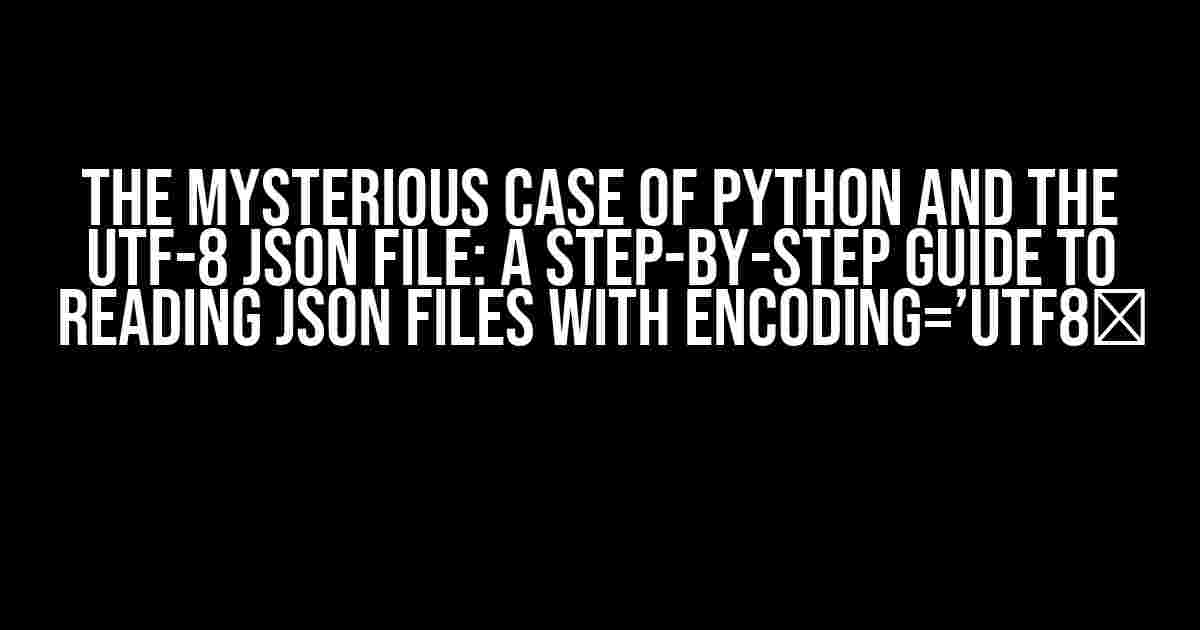Are you tired of encountering errors when trying to read a JSON file with encoding=’utf8′ in Python? Do you find yourself wondering why Python seems to be struggling with this task? Fear not, dear reader, for we are about to embark on a thrilling adventure to conquer this challenge and unlock the secrets of JSON file reading with Python!
What’s the Problem?
When trying to read a JSON file with encoding=’utf8′ in Python, you may encounter the following error message:
UnicodeDecodeError: 'utf-8' codec can't decode byte 0xXX in position YY: invalid continuation byte
This error occurs because Python’s default encoding is set to ‘ascii’, which is not compatible with the UTF-8 encoding used in the JSON file. But fear not, for we have a solution!
Solution 1: Using the ` encoding` Parameter
The first approach to reading a JSON file with encoding=’utf8′ is to specify the encoding parameter when opening the file. You can do this by using the `open` function with the `encoding` parameter set to `’utf-8’`:
with open('example.json', 'r', encoding='utf-8') as f:
data = json.load(f)
This code opens the `example.json` file in read mode (`’r’`) and specifies the encoding as `’utf-8’`. The `json.load` function is then used to parse the JSON data from the file.
Solution 2: Using the `io.TextIOWrapper` Class
Another approach is to use the `io.TextIOWrapper` class to wrap the file object and specify the encoding. This method provides more flexibility and control over the encoding:
import io
with open('example.json', 'r') as f:
wrapper = io.TextIOWrapper(f, encoding='utf-8')
data = json.load(wrapper)
This code creates a `TextIOWrapper` object around the file object, specifying the encoding as `’utf-8’`. The `json.load` function is then used to parse the JSON data from the wrapped file object.
Best Practices for Reading JSON Files with Encoding=’utf8′
To avoid common pitfalls when reading JSON files with encoding=’utf8′, follow these best practices:
- Always specify the encoding: When opening a file, always specify the encoding to avoid defaulting to the system’s encoding.
- Use the correct encoding: Make sure to use the correct encoding for the file, as specified in the file’s metadata or documentation.
- Verify the file’s encoding: Before reading a file, verify its encoding to ensure it matches the specified encoding.
- Handle encoding errors: Be prepared to handle encoding errors by using try-except blocks or error-handling mechanisms.
Common Pitfalls and Troubleshooting
When working with JSON files and encoding=’utf8′, you may encounter the following common pitfalls:
| Pitfall | Description | Solution |
|---|---|---|
| Invalid encoding | The specified encoding does not match the file’s actual encoding. | Verify the file’s encoding and adjust the specified encoding accordingly. |
| Mixed encoding | The file contains a mix of encoding types (e.g., UTF-8 and ASCII). | Use a library like `chardet` to detect the encoding and adjust the specified encoding accordingly. |
| Special characters | The file contains special characters that are not supported by the specified encoding. | Use a library like `html` to handle special characters and adjust the specified encoding accordingly. |
Conclusion
In conclusion, reading a JSON file with encoding=’utf8′ in Python can be a breeze when you follow the correct approaches and best practices. By specifying the encoding correctly and handling encoding errors, you can ensure that your Python code can read JSON files with ease. Remember to verify the file’s encoding, handle encoding errors, and adjust your approach according to the file’s specific requirements.
Bonus: Advanced Techniques for Reading JSON Files
For the adventurous reader, we’ve included some advanced techniques for reading JSON files:
- Using `json.JSONDecoder`: You can use the `json.JSONDecoder` class to specify a custom decoder for the JSON data.
- Using `io.BufferedReader`: You can use the `io.BufferedReader` class to read the file in chunks, which can be useful for large files.
- Using `gzip` and `bz2` libraries: You can use the `gzip` and `bz2` libraries to read compressed JSON files.
These advanced techniques can provide more flexibility and control when reading JSON files, but require a deeper understanding of the underlying mechanisms.
Final Thoughts
In the world of Python and JSON files, encoding can be a complex and nuanced topic. However, by following the approaches and best practices outlined in this article, you can conquer the challenges of reading JSON files with encoding=’utf8′ and unlock the secrets of the JSON universe.
So, go forth, dear reader, and conquer the world of JSON files with encoding=’utf8′!
Happy coding!
Here are 5 FAQs about “Python can not read JSON file with encoding = ‘utf8′”:
Frequently Asked Question
Got stuck with reading JSON files in Python? Don’t worry, we’ve got you covered! Here are some frequently asked questions about the issue.
Q1: Why can’t Python read my JSON file with encoding ‘utf8’?
This is because the ‘utf8’ encoding is not a valid encoding for JSON files in Python. The correct encoding for JSON files is ‘utf-8’ (with a hyphen). Make sure to correct the encoding in your Python script.
Q2: How do I specify the encoding when reading a JSON file in Python?
You can specify the encoding when reading a JSON file in Python by using the `encoding` parameter when opening the file. For example: `with open(‘file.json’, ‘r’, encoding=’utf-8′) as f: json.load(f)`. This tells Python to read the file with UTF-8 encoding.
Q3: What if I’m using the `json` module to read the JSON file?
When using the `json` module, you don’t need to specify the encoding explicitly. The `json` module will automatically detect the encoding of the file. Just use `json.load()` or `json.loads()` to read the file, and Python will take care of the encoding for you.
Q4: Can I use the `chardet` module to detect the encoding of the JSON file?
Yes, you can use the `chardet` module to detect the encoding of the JSON file. This can be useful if you’re not sure what encoding the file uses. Just install `chardet` using pip and then use `chardet.detect()` to detect the encoding of the file.
Q5: What if I’m still having trouble reading the JSON file?
If you’re still having trouble reading the JSON file, make sure to check the file’s contents and encoding. You can use a tool like Notepad++ or a hex editor to inspect the file’s contents and encoding. Additionally, try using a different JSON library or parsing the file manually to see if that resolves the issue.




